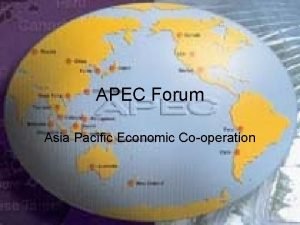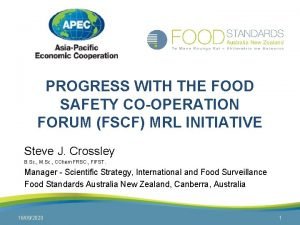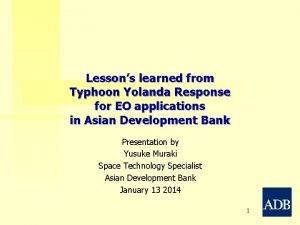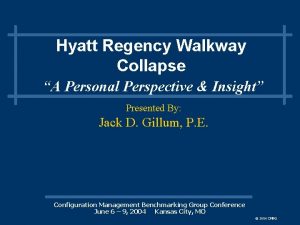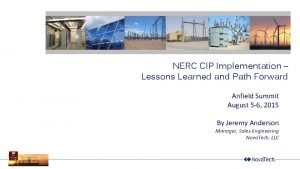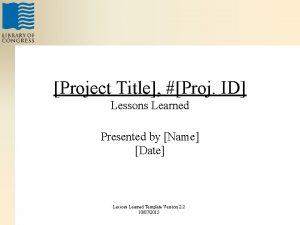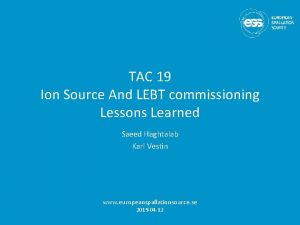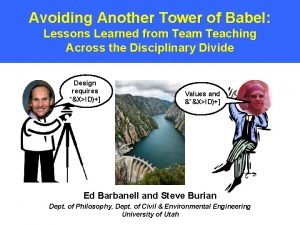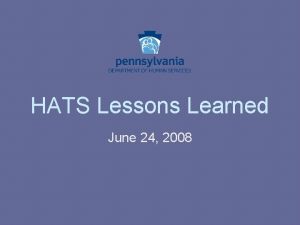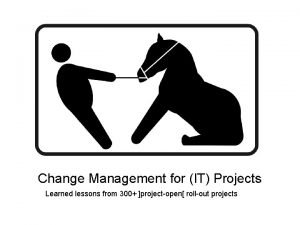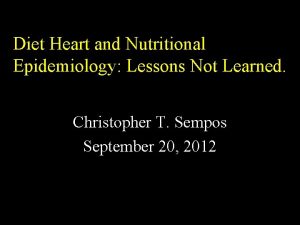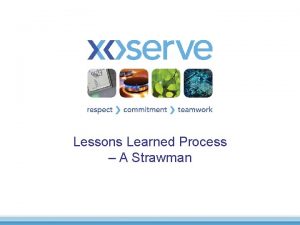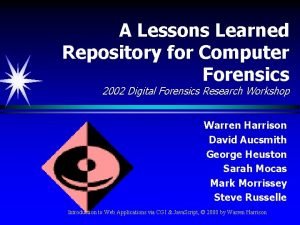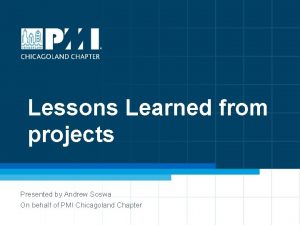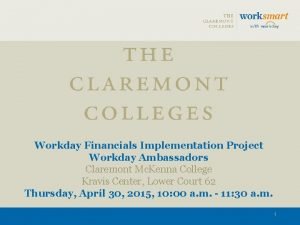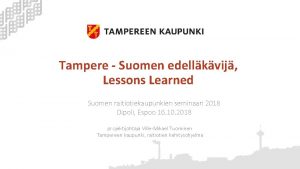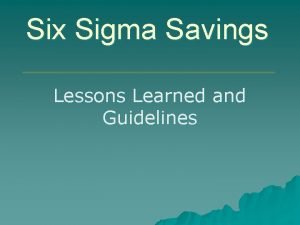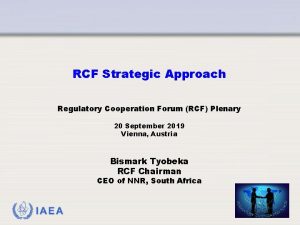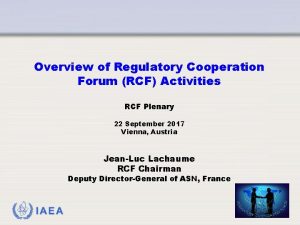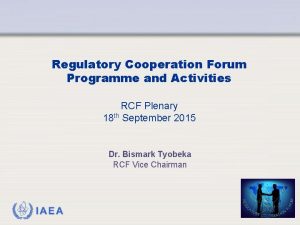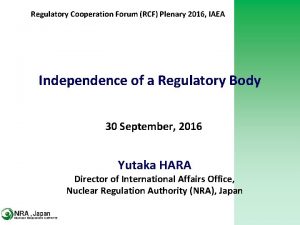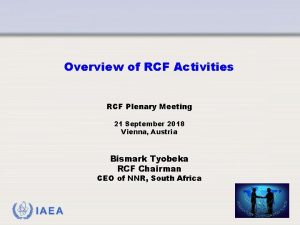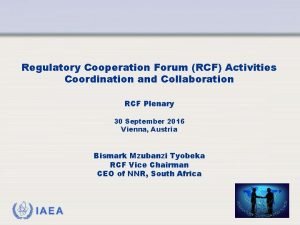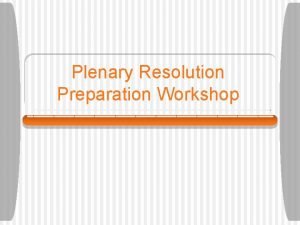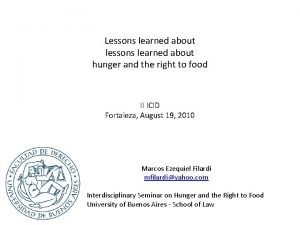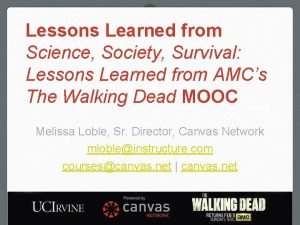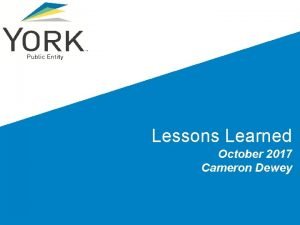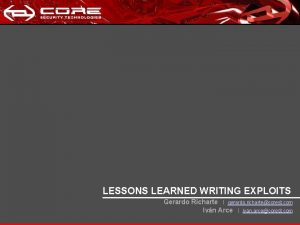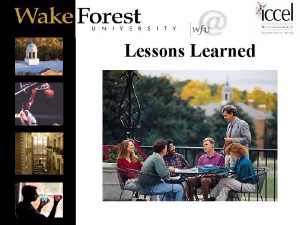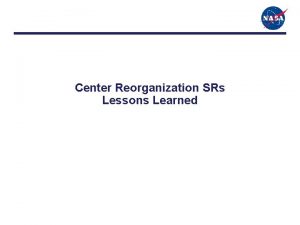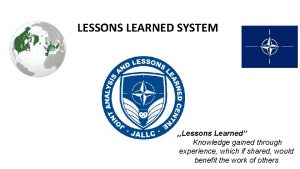Regulatory Cooperation Forum RCF Plenary 2015 LESSONS LEARNED



![Recent Conclusions I 1 • “[…] major accidents in the nuclear and other high Recent Conclusions I 1 • “[…] major accidents in the nuclear and other high](https://slidetodoc.com/presentation_image/02a7749486561830df11170cd948ac5d/image-4.jpg)















- Slides: 19

Regulatory Cooperation Forum (RCF) Plenary 2015 LESSONS LEARNED IN DEVELOPMENT OF SAFETY CULTURE FOR REGULATORY BODIES Stewart Magruder Senior Nuclear Safety Officer Regulatory Activities Section Division of Nuclear Installation Safety IAEA International Atomic Energy Agency

Contents • Background • Recent Conclusions • Safety Culture Initiatives at the IAEA • Development of Training Material • Support for Implementation • Summary IAEA RCF- Safety Culture of the RB

Background • The concept of the safety culture was introduced in INSAG-1, 1986 “-----formal procedures must be properly reviewed and approved and must be supplemented by the creation and maintenance of a ‘nuclear safety culture’” • Definition of safety culture – introduced in INSAG-4, 1991 and was revised in 2007 “Safety Culture is that assembly of characteristics and attitudes in organizations and individuals which establishes that, as an overriding priority, protection and safety issues receives the attention warranted by their significance”. • TEPCO’s Fukushima Daiichi Nuclear Power Station Accident - March 2011 • Ministerial Conference on Nuclear Safety in Vienna, Austria - June 2011 • Nuclear Safety Action Plan to strengthen nuclear safety worldwide - September 2011 (12 Point Plan - 200 Actions) • The Fukushima Daiichi Accident – Report by the Director General 2015 IAEA RCF- Safety Culture of the RB
![Recent Conclusions I 1 major accidents in the nuclear and other high Recent Conclusions I 1 • “[…] major accidents in the nuclear and other high](https://slidetodoc.com/presentation_image/02a7749486561830df11170cd948ac5d/image-4.jpg)
Recent Conclusions I 1 • “[…] major accidents in the nuclear and other high hazard industries most frequently derive from organizational and human factors. Several Contracting Parties reported adopting a systematic consideration of safety culture characteristics in inspection and oversight processes. Some regulatory bodies and licensees have in place specific safety culture programmes ……. . These include periodic internal and external safety culture assessments. ” Summary Report of the 6 th CNS Review Meeting (24 Mar – 4 Apr 2014) • Incorporation of safety culture into regulatory processes • Dialogue with licensees to enhance the understanding of safety culture aspects • Licensees’ commitment to perform self-assessments and independent peer assessments of safety culture on a regular basis. • Establishment of an enduring safety culture remains essential and regulatory bodies should take the necessary actions in this direction. • High level commitment of Member States to peer reviews (participation in the CNS and hosting IRRS) • Regulatory bodies should foster an environment that encourages licensees to invest in improvements beyond national requirements. IAEA RCF- Safety Culture of the RB

Recent Conclusions I 2 IAEA Report on Strengthening Nuclear Regulatory Effectiveness in the Light of the Accident at the Fukushima Daiichi Nuclear Power Plant (2013 ) • A systemic approach to safety needs to consider the interactions between human, organizational and technical factors. This approach needs to be taken through the entire lifecycle of nuclear installations. ” The Fukushima Daiichi Accident – Report by the Director General (2015) IAEA RCF- Safety Culture of the RB

Implementation of Safety Culture Initiatives at the IAEA • Development of IAEA Safety Standards; • Development of Training Material on Safety Culture and Safety Culture Self-Assessment; • Technical Meeting on Integration of Safety Culture into Regulatory Practices and the Regulatory Decision Making Process; • Support for implementation of Standards and Training Material; • Self Assessment and Peer Review Missions for improvement. IAEA RCF- Safety Culture of the RB

IAEA Safety Standards – Safety Culture Principles for protecting people and environment Requirements to be applied to meet the principles (shall) Recommended ways of meeting the requirements (should) Safety Fundamentals Safety Requirements Safety Guides Safety reports, TECDOCs … IAEA RCF- Safety Culture of the RB 7

Development of IAEA Safety Standards – Safety Culture Safety & Performance Systemic approach n tio bli ca r Pu de Un GSR Part 2 2014 (Integrated) Management Systems r de on Un icati l b Pu GS-R-3 2006 Quality Management 50 -C-Q 1996 Quality Assurance Quality Control 50 -C-QA 1985 -88 Time In preparation Under Publication Draft GS-R Part 2 n tio ca bli de r Pu Un How to Perform Safety Culture Self-Assessment - draft Guidelines for Self Assessment of Safety Culture for Regulatory Bodies - draft IAEA How to Perform Safety Culture Self. Assessment - draft TECDOC- Safety Culture for Regulatory Bodies - draft How to Perform Safety Culture Self-Assessment draft How to Perform Safety Culture Self. Assessment - draft How to Continuously Improve Safety Culture - draft RCF- Safety Culture of the RB

Development of IAEA Safety Standards – Safety Culture 3. 12. “…Safety has to be achieved and maintained by means of an effective management system. ……. . . The management system also has to ensure the promotion of a strong safety culture…” 3. 14. “……. management system is the recognition of the entire range of interactions of individuals at all levels with technology and with organizations. …. . ” [Principle 3: Leadership and management for safety (SF-1)] • • Requirement 1: Demonstration of leadership by senior management Requirement 2: Demonstration of leadership for safety by managers at all levels Requirement 13: Continuous improvement of safety culture Requirement 14: Assessment of leadership and safety culture [New Developments GS-R Part 2] IAEA RCF- Safety Culture of the RB

Establishment of Nuclear Safety Infrastructure – Training Material on IAEA Safety Culture Self-Assessment has been developed under Safety packages based on SSG-16 under Module 1 - Legal Governmental and Regulatory Framework for Safety • Workshop (8 a) - Leadership, Management for Safety and Safety Culture • Workshop (8 b) - Safety Culture for Regulatory Bodies • Ambassador Workshop (2 Weeks) • Senior Management Workshop (3 Days) • Train the Trainer (1 Week) Implemented at PNRA as a pilot project Lessons Learned: • Training Material provided a better understanding of the safety culture concepts for staff at PNRA; • • • IAEA should have put more efforts in the promotion of the training material; More regulators from Member States should have taken part in the pilot project; Member States when undertaking a commitment to perform SCSA should ensure appropriate resources and time for completion of the project in a timely manner. IAEA RCF- Safety Culture of the RB

Technical Meeting on Integration of Safety Culture…. I 1 • The IAEA organized a Technical Meeting on Integration of Safety Culture into Regulatory Practices and the Regulatory Decision Making Process at Vienna, Oct. 2014: • Regulators from countries embarking on nuclear power program and those regulating only radiation facilities showed great interest on the importance of safety culture IAEA Observation - Regulators regulating only radiation facilities should be encouraged to conduct SCSA • A common understanding and awareness was observed of regulators’ dual role – oversight of the licensees’ safety culture and the regulatory body’s internal safety culture and its impact on the licensee’s safety culture. IAEA Initiative - IAEA developed a 3 days training material for senior management of the RB create awareness of this issue IAEA RCF- Safety Culture of the RB

Technical Meeting on Integration of Safety Culture…. I 2 • Safety culture continuous improvement is a big challenge for all regulators, specifically the newcomers who start from the beginning by establishing a management system and integrating measures to continuously strengthen safety culture into this system. • Conclusion of the TM: Work needs to be initiated in collaboration with the Member States to address the challenges and move forward into integrating safety culture into regulatory practices and the decision making process. IAEA RCF- Safety Culture of the RB

Support for implementation of Standards and Training Material • Development of the IAEA guidelines for the conduct of safety culture self-assessment by the regulatory bodies is progressing well; publication is expected in early 2016. • IAEA has initiated the development of a TECDOC, which will describe practices adopted by Member States for addressing safety culture within the regulatory bodies, including selfassessment. IAEA

Self Assessment and Peer Review Missions for improvement • Currently, the area of regulatory body’s safety culture is reviewed during the IRRS missions, as part of the module addressing the management system; • More effort will be put into IRRS to look in more depth at the area of safety culture; • IAEA is working on the development of a question set on safety culture to be used in the descriptive analysis of the self assessment methodology; • IAEA is aware of OECD/NEA efforts regarding safety culture for the regulatory bodies; • Further work needs to be done in the area of independent assessment of safety culture. IAEA RCF- Safety Culture of the RB

Conclusions • Additional IAEA guidance for regulators in the area of safety culture is under development • Regulatory bodies should consider conducting selfassessments of safety culture on a regular basis • Peer reviews (e. g. IRRS ) should put more emphasis and exchange information on regulatory body’s safety culture IAEA 15 RCF- Safety Culture of the RB

TM on Regulatory Oversight of HOF • Culture of an organization influences human behaviour through the values, beliefs and assumptions held by the personnel • Other Human and Organizational Factors (HOF) may positively or adversely influence the performance of humans and organizations • HOF are related for instance to: • • • Organization of an activity, workload, working hours Work management and supervision Layout of the workplace and physical environment Equipment, tools, aids, procedures Communication. . . • HOF are critical for safe operation, directly or indirectly, and should not be separated from technical aspects IAEA RCF plenary meeting 16

TM on Regulatory Oversight of HOF • At various regulatory forums, participants noted room for improvement in the regulatory assessment capabilities of licensees’ programmes in the area of HOF and in the conduct of oversight, including inspection • Regulatory bodies should widen the scope of their classical oversight approach from a rather technical focus to also cover HOF Technical Meeting on Regulatory Oversight of Human and Organizational Factors | 14 – 18 December 2015 IAEA RCF plenary meeting 17

TM on Regulatory Oversight of HOF • To assist Member States in understanding: • Importance of and Regulatory Strategies for HOF Oversight • Regulatory approaches and methods to verify that the licensee effectively manages HOF • Other provisions to promote the positive contribution of HOF to safety and to mitigate possible adverse effects • To provide an opportunity for participants to share and discuss their experience related to the effective oversight of HOF Results to be used for preparing a publication on the regulatory oversight of HOF (Priority identified by the CSS) IAEA RCF plenary meeting 18

TM on Regulatory Oversight of HOF Technical meeting on Regulatory Oversight of Human and Organizational Factors in Nuclear Facilities and Activities VIC, Room M 0 E 03 14 – 18 December 2015 Contact: j. jubin@iaea. org IAEA
 Asia-pacific economic cooperation forum
Asia-pacific economic cooperation forum Apec food safety cooperation forum
Apec food safety cooperation forum Lesson learned in typhoon yolanda
Lesson learned in typhoon yolanda Hyatt regency bridge collapse
Hyatt regency bridge collapse Nerc lessons learned
Nerc lessons learned Dps project title
Dps project title Tac lessons learned
Tac lessons learned Life lessons from the tower of babel
Life lessons from the tower of babel Lessons learned from king josiah
Lessons learned from king josiah Lessons learned ground rules
Lessons learned ground rules Change management lessons learned
Change management lessons learned Lessons not learned in blood
Lessons not learned in blood Lessons learned purpose
Lessons learned purpose Lessons learned repository
Lessons learned repository Lesson learned register
Lesson learned register Learn from ants
Learn from ants Workday claremont colleges
Workday claremont colleges Obadiah (1 kings)
Obadiah (1 kings) Lessons learned suomeksi
Lessons learned suomeksi Six sigma lessons learned
Six sigma lessons learned
